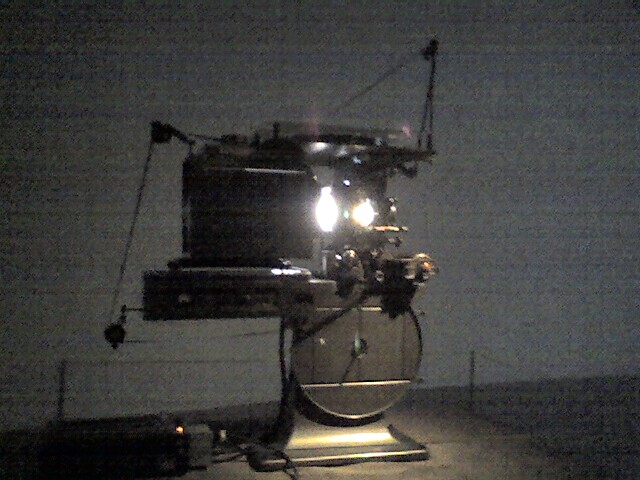
Week 7 Discussion Guide: Tuesday
In class, we will review some of the terms and talk about how to analyze film, starting with its elements which resemble printed fiction (character, plot, theme, and symbol; structural oppositions in themes, characters, plot elements). Introductory discussion of the film illusion (persistence of vision, montage, makeup and simulation), showing vs. telling (image/dialogue, drama/narration, high-contrast/chiaroscuro, etc.). Please read the entire glossary of terms of art used by film students to describe their primary sources. The glossary is too brief to include all the terms and persons relevant to making a modern movie. How many more can you think of to add?
Films almost never are shot in the sequence in which we view them. Instead, films shot in the most economical order of scenes depending on which people and sets are available, just as you should write your papers in segments based on an overall plan but in the order in which you feel able to develop the segments. (E.g., rarely are good introductions written first unless you are a very experienced and proficient single-draft writer.) After shooting and assembly, films are edited just like your papers to add clarity, coherence and unity, as well as other fiction-related effects (obscurity, chaos, and divided plot strands, as in Hawthorne's short stories). Sometimes, editorial decisions make enormous differences between the film-as-shot and the film eventually released to the public. To help us discuss how "shots" (camera work) and "montage" or "editing" (combining shots into sequences) create the illusion of a film, watch this short excerpt from Orson Welles' Citizen Kane (1941). View it once just to get a sense of what the whole sequence of shots is about. Then, view it again several times while keeping track of how the camera is positioned, how the camera moves, how characters are framed in the shot, and how the combination of camera position/movement and framing shapes our perception of the action. In class, you will get a chance to practice using this professional vocabulary for describing film in preparation for our writing about Casablanca or The Third Man.
A Note on Citizen Kane:
The movie tells of a reporter's search for the "hidden story" behind the life and death of an American muilti-millionaire named Charles Foster Kane (a thinly disguised portrait of the newspaper magnate, William Randolph Hearst). The four-minute scene you will watch opens with the reporter reading a memoir written by a banker who knew Kane since his early boyhood when the bank was assigned as the boy's guardian. The "reading" scene is transformed into a "flashback" by a masterful close-up of the white page and a cut-away shot to a snowy landscape in the distant past into which the young boy slides on his sled. The remainder of the scene dramatizes the banker's discussion of the terms under which the bank will undertake custody, and reveals the source of Kane's wealth. His mother ran a boarding house in Colorado during the C19 gold rush, and an indigent miner left her deeds to what turned out to be a fabulously rich gold deposit. The scene discloses the tensions between Kane's mother and his father, and suggests that the boy's departure for the East Coast may have left him with grave emotional scars. As an illustration of "depth of field" and interlaced dialogue, this shot sequence has been considered a classic. Those who know the movie's famous conclusion will know the secret the scene holds, which is revealed in the last shot sequence, and how it relates to the movie's opening sequence involving a shattered snow globe at the moment of Kane's death. The entire plot revolves around this flashback, both aesthetically, in terms of its images, and dramatically, in terms of the psychological relationships it suggests.
"Film" vs. Digitally Shot and Projected Movies:
The first "moving pictures," so called to differentiate them from still photography, were shot in the late C19 on flexible strips of a "film base," originally nitrocellulose (a highly flammable compound) and later cellulose triacetate, which were threaded through the shooting camera or projection camera using sprocket holes on either side of the image. The "film" which coated the shooting stock was a light-sensitive chemical emulsion which reacted to wavelengths of light and reproduced, in miniature chemical reactions on the film surface, the images before the camera lens. Sound captured by audio recording was registered in electromagnetic strips which paralleled the visual images (see below). The number of images per second, and the speed with which the camera motors moved them past the photographic or projection lens, was governed by the rate of human beings' "persistence of vision," the roughly 1/64th of a second that the brain retains a previously seen image before replacing it with the next one. With the introduction of digital video, the light and sound are captured at much higher rates, measured in megabits of data per second, and projected on digital screens' pixels in fine detail, though not as fine as the film emulsion on old-fashioned film stock, which is literally accurate to the molecular level. With the advent of completely digital film recording, computer-generated and computer-enhanced imaging has become commonplace in many movies.
A Zenith 35 mm. Film Projector (roughly six feet high)

Frames of a 35 mm. Movie--Two "Sound Tracks" Coded on the Left